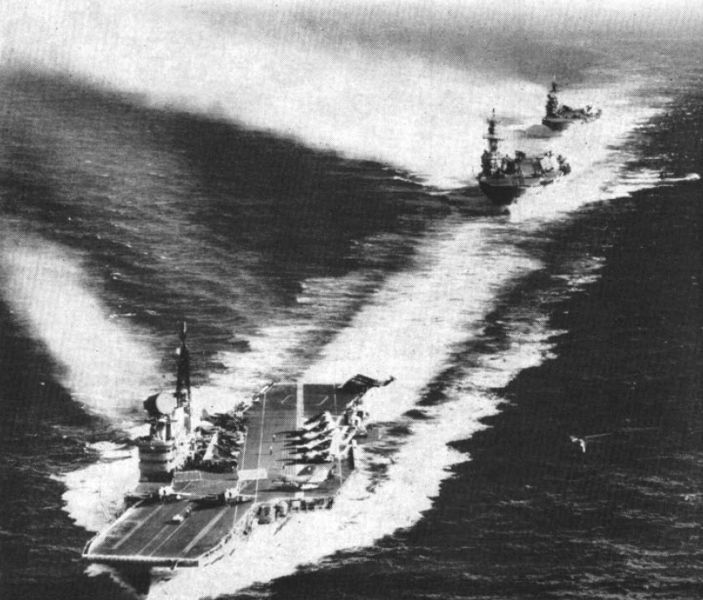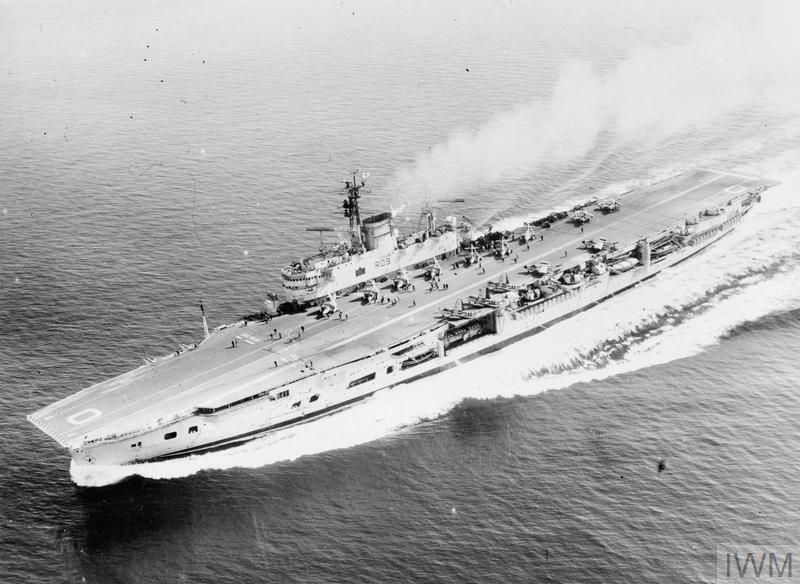During the 1930s, as the world’s major navies began rearming, it was clear that aircraft carriers were going to play a significant role in any future combat. Just how significant was not wholly anticipated at the time – but there was no question that carriers were going to be part of it, one way or another.
At the time there were a number of competing ideas relative to what constituted an effective carrier design. Some were odd by later standards, such as the notion that a carrier might recover aircraft over the bow, demanding high astern speed and a stern shaped to permit that speed. The biggest debate, however, was over basic principles. United States carriers were built with the Pacific in mind and called for the hangar and flight deck to be built as a superstructure over the hull, with deck parking to store some of the aircraft. This ‘open’ construction had advantages, notably in terms of aircraft stowage. There was also room and ventilation to warm aircraft engines up below decks. The down side was that the aircraft and flight deck had no protection from bombs or projectiles.
This concerned the British, who expected their own carriers to operate within range of land-based aircraft, likely in conditions of enemy air superiority.[1] The inter-war idea that a carrier might have to face shell-fire also entered the calculation. The Admiralty’s 1936 programme – intended for laying down in 1937 – included two aircraft carriers, and the Third Sea Lord, Admiral Sir Reginald Henderson, pushed for a design featuring armour protection, and was able to get them accepted while the Director of Naval Construction, Sir Arthur Johns, was absent and the department very busy. The resulting ships were developed in just three months by W. A. D. Forbes, head of the aircraft carrier design department, and were very different from both US and earlier British designs. The hangar and flight deck were integral with the hull, and the hangar and part (but not all) of the flight deck were protected by an armoured ‘box’.[2] The plus side was good citadel protection against small projectiles and some bombs, but it came at a cost of aircraft carrying capacity, usually less than half that of a US carrier of equivalent displacement.[3] The closed hangar implied risk relative to petrol fumes, which the British addressed with a number of systems including special ‘fire curtains’ to divide the hangar, along with salt-water sprays.[4]
There were other differences too. United States designers typically did not allow much to intrude into the flight deck area. The British, by contrast, allowed a relatively heavy anti-aircraft armament to do so, again because of the expectation of having to operate under direct enemy air attack. The 4.5-inch twin turrets were partially countersunk but nonetheless notched into the flight deck, and protruded above its level to provide cross-deck firing capability.[5] Nor did the British accept on-deck parking, in part because they required their carriers to operate in severe North Atlantic sea states where the flight deck was likely to be soused. Such sea-states also required enclosed bows.[6]
Both styles of ship had their own advantages, and while the armoured carriers were theoretically optimal for confined European waters – whereas US style ships were developed more for open-water Pacific operations[7] – both navies looked at the other’s designs with some envy. One outcome was a US effort to look into improved armour protection, leading by 1941 to the decision to build what became the Midway class which included STS (special-treatment steel) protection, specifically on the basis of British war experience.[8] Later, the apparent ease with which the British carriers survived Japanese kamakaze attacks – by comparison with US carriers, which often required weeks of repair work – seemed to clinch the image. In fact, the British carriers were not quite as kamakaze-proof as legend suggested; the impacts produced structural damage even if the flight deck was not penetrated. However, they were certainly more resistant than US vessels.
The British, by contrast, were attracted by the carrying capacity of the US ships and their ability to launch large numbers of aircraft quickly. The relatively small carrying capacity of the first British armoured carriers was only partially addressed by modifying the follow-on ships, and in the end the British had to accept deck parks, particularly in Mediterranean and Pacific service. Even then they did not approach US levels, and the carriers demanded more frequent replenishment because avgas capacity had been geared around the original air-wing. Nor were hangar heights well-suited to some of the larger US aircraft being brought in to the Fleet Air Arm, such as the Corsair.
None of this was optimal, and the broad limitations of the armoured design were clear by 1942 when plans for their successors, the Audacious class, were well in hand.[9] What might follow fell within the ambit of the ‘Future Building Committee’. The work was further informed by a Joint Technical Committee which felt that future naval aircraft would weigh up to 30,000 lb.[10]
A series of carrier designs were then prepared by the Director of Naval Construction, Sir Stanley Goodall; and what emerged was the Malta class. Official orders were placed as early as mid-July 1943, even while the Board pondered sketch-design options: Gibraltar with the Vickers-Armstrong Walker yard; Malta with John Brown’s Clydebank yard; and New Zealand with the Cammell Laird yard at Birkenhead. The Board of Admiralty apparently regarded this class as more significant than the Audacious class, and so a fourth, Africa, was ordered from Fairfield Shipbuilding at Govan, in substitution for the fourth Audacious class carrier.[11] The naming theme reflected both the Mediterranean war and the North African land campaign, where New Zealand ground forces played a pivotal role.[12]
Work was at first expected to begin on the Malta-class carriers during early 1944,[13] and initially the Board of Admiralty favoured a 61,060-ton closed-hangar design that Goodall prepared in October 1943. However, although Goodall’s design was ready for Board approval in April, Vice-Admiral Sir Denys Boyd – the Fifth Sea Lord – instead called for an open-hangar design able to fly off its aircraft relatively quickly. His view prevailed, and this led to ‘Design X’, which at 900 feet on the waterline seemed too large; then ‘Design X1’, which was smaller but still expected to have a full-load displacement of more than 56,000 tons.
The Board selected ‘Design X1’ for further development in April 1945. Actual construction would have produced slightly different particulars, and the details in any case have been variously cited.[14] However, the general picture involved a deep load displacement of about 57,800 tons, an overall length of 897 feet, and 200,000 horsepower for a speed of 33 knots. The flight deck was a superstructure, US-style; and the hangar deck and sides below it were armoured along the length of the citadel.[15] Unique features included a double island structure, split to enable the flight-deck expansion joint to move. The islands were also streamlined to improve buffeting over the flight deck.[16] Efforts were also made to avoid compromising flight operations with the anti-aircraft guns.
The flight deck itself included two deck-edge lifts.[17] The class were expected to carry more than 90 aircraft, and were intended to be fitted with catapults that could bring a 30,000 lb aircraft up to 130 knots for launch. They were also going to be fitted with arresting gear that could stop a 20,000 lb aircraft from 75 knots.[18]
Time and other war priorities, in the end, ran against them. The developed designs came up for approval in late August 1945 – a fortnight after the end of the war with Japan – at which point the Board postponed further decisions. Orders for the four were then cancelled at the end of 1945, after some material had been assembled to build them, but before work had apparently begun.[19] The Admiralty still envisaged a significant post-war carrier force.[20] Many were going to be new, including the Audacious class fleet carriers and various lighter carriers of the Colossus, Majestic and Centaur classes still on order or under construction.[21] However, Britain was essentially bankrupt, and plans for a significant post-war fleet faded. Many planned ships were cancelled, or their construction strung out as a cost-saving exercise.
Had the Maltas been built, Britain would have had four ships comparable to the US Navy’s Midways, with an effective life spanning several decades. Like the Midways, they would likely have been rebuilt in due course with angled flight decks and the other innovations of the 1950s. Or they might have been modified during construction to those standards, in similar fashion to the Audacious class carrier Ark Royal, laid down in May 1943 but whose construction was slowed by the end of the war. She was finally commissioned in 1955 with an angled flight deck and steam catapults.
As matters stood, of course, neither the Malta class nor the next proposed large British carrier, CVA-01 of the early 1960s, got as far as construction. It was not until December 2017 that an aircraft carrier of this general scale was commissioned into the Royal Navy. Such were the financial realities that Britain faced in the second half of the twentieth century.
For more works by Matthew Wright, check out these other articles:
HMS Vanguard: Britain’s Last Battleship
Copyright © Matthew Wright 2019
[1] See, e.g. http://www.armouredcarriers.com/debunking-slade-and-worths-armoured-carrier-essays/2014/5/30/debunking-slade-and-worths-armoured-carrier-essays
[2] Hobbs, p. 83.
[3] http://www.armouredcarriers.com/hms-illustrious-armoured-aircraft-carrier-design/
[4] Hobbs, p. 83.
[5] Ibid, p. 85.
[6] http://www.armouredcarriers.com/debunking-slade-and-worths-armoured-carrier-essays/2014/5/30/debunking-slade-and-worths-armoured-carrier-essays
[7] See http://www.armouredcarriers.com/debunking-slade-and-worths-armoured-carrier-essays/2014/5/30/debunking-slade-and-worths-armoured-carrier-essays
[8] War Damage Report No. 45: ‘USS Franklin (CV13)’, Preliminary Design Section, Bureau of Ships, Navy Department, September 1946, pp. 22-23.
[9] See http://www.armouredcarriers.com/hms-audacious-class-armoured-flight-deck/
[10] David Hobbs, British Aircraft Carriers: Design, Development and Service Histories, Seaforth, Barnsley, 2013, p. 212.
[11] Hobbs, p. 215.
[12] Role noted in Matthew Wright, Desert Duel, Intruder Books, Wellington 2018.
[13] Hobbs, p. 215.
[14] Compare, e.g. Wikipedia with Hobbs, p. 215.
[15] Hobbs, p. 215.
[16] Ibid, p. 212.
[17] Ibid, p. 213.
[18] Thomas C. Hone, Norman Friedman and Mark D. Mandeles, Innovation in Carrier Aviation, Centre for Naval Warfare Studies Newport Paper 37, August 2011; Naval War College Press, Rhode Island, p. 85.
[19] Hobbs, p. 215.
[20] Hone, Friedman and Mandeles, pp. 84-85.
[21] Clare M. Scammell, ‘Anglo-American Strategic Co-operation: the role of carrier aviation in western strategy, 1945-55’, PhD thesis, Department of War Studies, King’s College, London 2001, p. 24.







Recent Comments